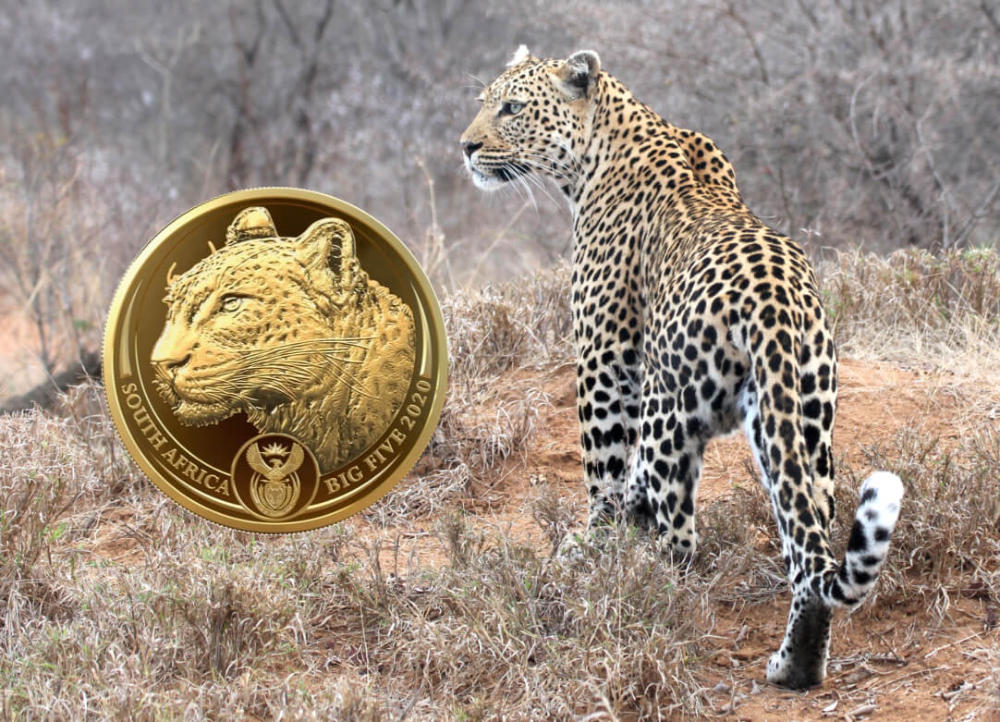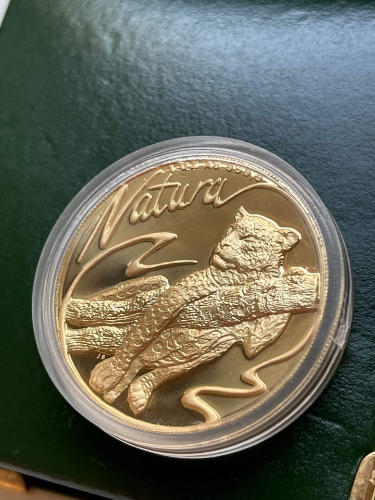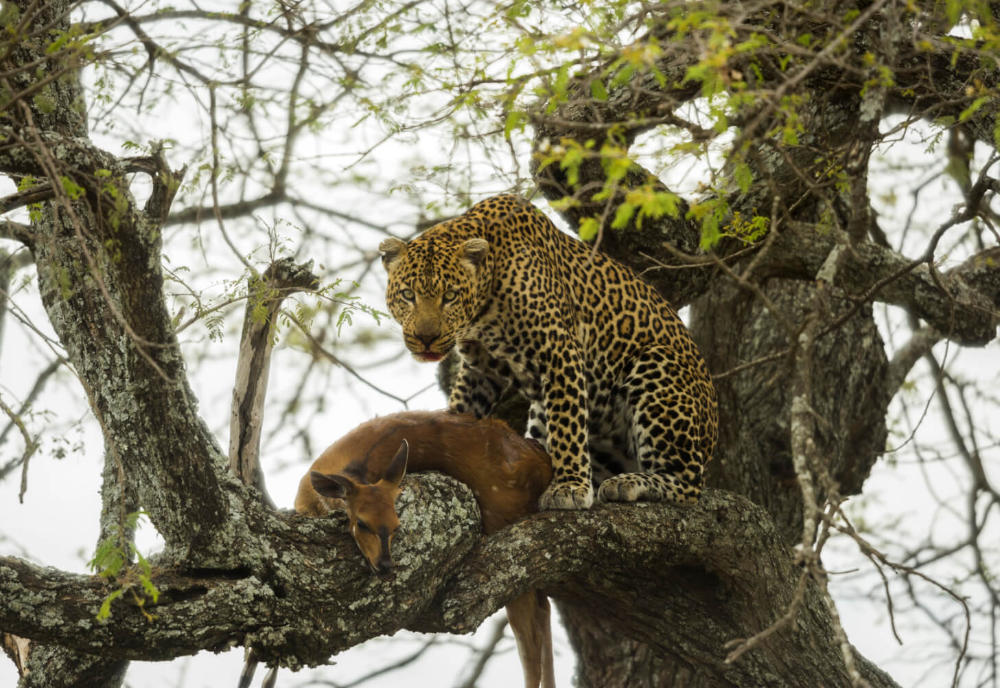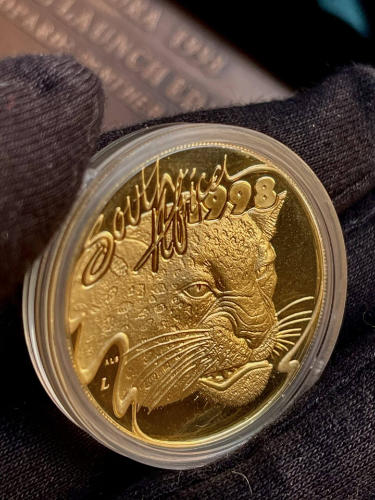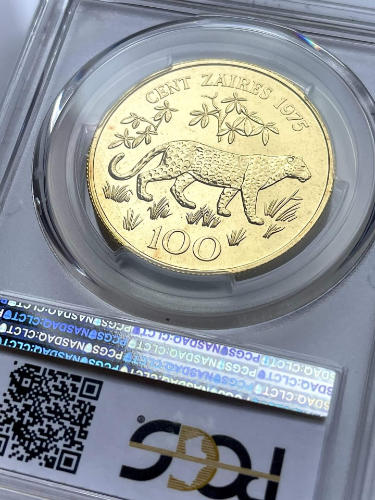A Perfect Hunter: The Leopard on African Coins
The African continent exudes a mysterious attraction that casts a spell on anyone who has visited it. Once aroused, this fascination will stay with them forever. One reason for this is the continent’s incredibly rich wildlife. The so-called Big Five are considered the pinnacle of this fauna – five majestic animals that every tourist desperately wants to see on a safari. Today, we want to focus on the shyest of these creatures and on how it is depicted on rare African coins. We are talking about the leopard.
Content
Like Greased Lightning out of the Shadows
The cheetah is quicker, the lion is stronger. But the leopard combines strength and agility in a way that makes it one of the most talented hunters in the animal kingdom. The big cat with its distinctive pattern is a master of camouflage, a skilful climber, an excellent swimmer and a true jumping champion. Thanks to its exceptional eyesight, the leopard can hunt even if it is almost completely dark. They are quick, but rarely willing to chase their food for long. They prefer to silently stalk their prey or patiently lie in ambush to then leap at unsuspecting animals at lightning speed before they have a chance to escape. In this way, the leopard also dares to hunt animals that are much larger than itself.
Leopards are extremely adaptable and can survive in different habitats such as rainforests, mountains, savannahs and even deserts. That explains why there used to be a large population all over Africa and parts of Asia.
Even experts need a great deal of luck to actually spot a leopard. They are solitary, nocturnal animals and perfect at hiding despite their size. For this reason alone, it is something very special to see a leopard for many safari participants.
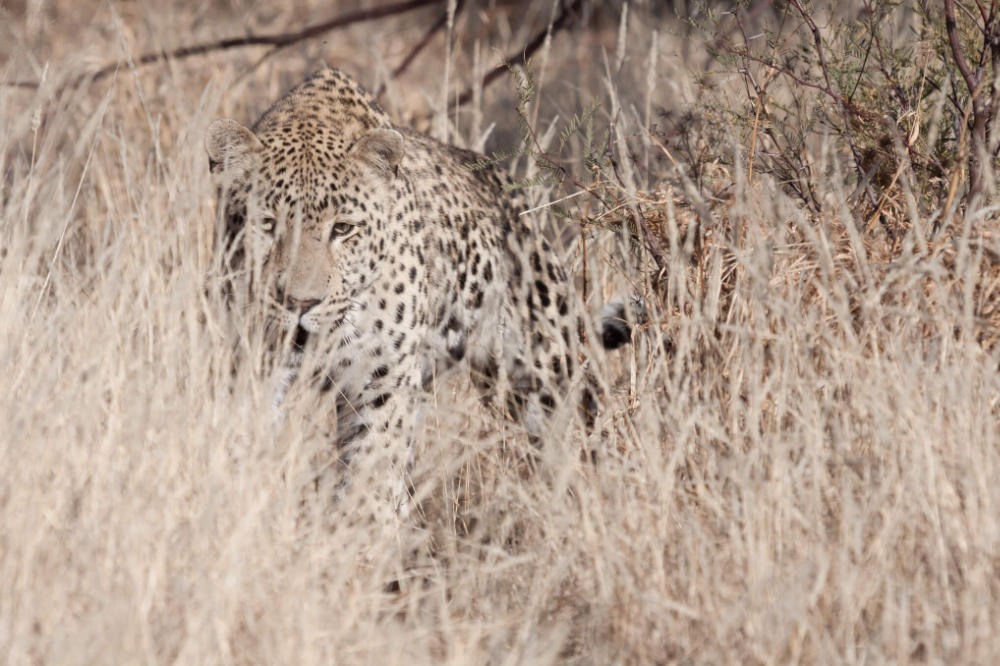
Leopards are experts at lying in ambush. It almost impossible to spot them in the wild if they do not want to be seen. Photo: Arunasit via Shutterstock.
The Leopard on Coins
Leopards symbolise the beauty and wildness of the African continent and are considered incredibly fascinating both by locals and tourists. This is reflected by the fact that many African countries dedicate coins to the elegant big cat, especially gold versions of collector coins. These issues are highly popular as they provide enthusiasts with the possibility to bring a piece of Africa into their homes in the form of a valuable collectible. They epitomise the fascinating relationship between the majestic leopard and the cultural richness of Africa.
Dirk Wasserthal is the managing director of RareCoin and specialises in the rarities of modern numismatics. He is well aware of the intriguing charm of Africa: “We have a lot of customers who have been to Africa and who just can’t forget about the continent. For them, African coins with wildlife motifs are obviously a great way to channel this interest, especially because the pieces are often rare and have the potential to increase in value. We regularly offer such issues. The customers highly appreciate them.”
Together with Dirk Wasserthal, we want to present five African gold coins that show the leopard. Join us on our numismatic safari!

South Africa: Big Five I, Leopard 2020, 1 ounce, gold, Proof. The depicted specimen was graded NGC PF70. Photo: RareCoin.
1) The Leopard in South Africa’s Big Five Series: A Masterpiece of Minting Technology
The first piece is probably the most beautiful leopard coin of recent years. It was issued by the South African Mint in 2020 as part of a Big Five series, which had been launched one year earlier. 500 specimens were minted of this 50-Rand gold coin, additional versions were released in other denominations and metals. We see a remarkably detailed head of a leopard; the attentive eyes look at the horizon, its ears are pricked up. The details of the spot pattern and the whiskers are a delight to every fan of numismatic animal depictions. They particularly stand out on Proof versions, like this one, that was declared absolutely flawless with the best grade out there, PF70, by NGC.
Dirk Wasserthal says that the South African Mint did everything right with this series: “The Big Five series was an incredible success for the mint. The small mintage figure combined with carefully selected and executed motifs; it simply hit the spot. The prices of these issues are already increasing significantly on the secondary market. By the way, the demand was so tremendous that the South African Mint launched a second Big Five series. Therefore, leopard heads can be seen once again on South African coins this year.”
2) An Older Leopard from South Africa
The coin of the Big Five series was not the first gold coin that South Africa dedicated to the leopard. Our next example is from 1998: a gold 100-Rand coin in Proof quality. It is part of the Natura series dedicated to Africa’s wildlife. Started in 1994, the series has been around for almost 30 years. It has become a true classic, whose coins always sell out quickly due to the low mintage figures. Only 2,645 specimens were produced of this rare coin. The leopard can be admired twice on it: while an angrily looking leopard head is depicted on the reverse, the obverse features a rather relaxed leopard dangling his legs from a branch.
Ein Leopard mit seiner Beute auf einem Baum. Foto: Eric Isselee via Shutterstock.The motif is well chosen because one of the special characteristics of leopards is that they are excellent climbers who like to climb trees. Not only do trees provide the animals with a shady place to relax in the midday heat, they also offer a good view of the surrounding area and potential prey. It happens that leopards lunge at their prey from this position. They also tend to drag hunted animals on trees to dine there, safe and undisturbed.
3) Natura, the Second: Even Rarer with Mint Mark
Here is an excellent example to illustrate why details can make all the difference on a coin. It is a very rare special issue of the coin we just presented. The only difference: next to the leopard’s head on the obverse, there is an L. It refers to Londolozi, one of the best-known private wild reserves in South Africa. With issues like this, the South African Mint supports national parks and the preservation and protection of animals – and creates true rarities.
Dirk Wasserthal explains: “South Africa repeatedly issues highly rare special issues of its coins that can only be identified by a monogram; this is also the case with the Krugerrand, for example. In this way, they show their support and appreciation for the country’s many national parks and game reserves. You should definitely check whether you have such letters on your coin, in that case, they are much rarer than normal issues! For example, only 300 specimens were minted of this coin.”
Londolozi was not chosen at random – the reserve is known for its leopard population and refers to itself as “a mecca for leopard viewing”. Thus, this is a perfect coin for all those who were lucky enough to go on a safari in South Africa and like to look back on this unforgettable time.
4) Somalia’s Leopard Series: Investment Products and Attractive Collectibles
Somalia has a particularly close relationship with the leopard: it is the country’s national animal. Moreover, Somalia’s coat of arms is held by two leopards, as is often seen on the country’s coins.
Since 2018, this relationship has also been expressed numismatically: a Somali bullion coin of the African Wildlife Series is dedicated to the leopard. Its special feature: like China’s panda bullion coin, the leopard motif changes every year, making the coin an interesting object for gold investors and collectors alike. This is the 2021 issue. Once again, the leopard is depicted on a branch, towering above the savannah, which stretches out in the background. 1,000 specimens were minted of this 1,000 shillings / 1 ounce coins. Collectors should definitely watch out for this series.
5) Zaire: Leopards Need Our Protection
Among Africa’s early leopard gold coins is this piece from the Republic of Zaire, now called the Democratic Republic of the Congo. Depicted from the side, the leopard struts through a sketched landscape. It was produced by the Royal Mint in Wales. Only 1419 specimens were created, which is why the pieces saw a significant increase in value, especially regarding high-quality coins with grading certificates, such as the one you can see here. Proof issues are even rarer.
This coin shows us how people became aware of the need to protect wildlife at the time. After all, it was issued to celebrate the 15th anniversary of the World Wildlife Fund, the WWF. The WWF put the leopard on the red list of threatened species. Even these impressive survivors reach their limits when humans destroy their habitat and poachers hunt them for their coveted hide. The African leopard’s territory has shrunk to just a quarter of its former habitat. Likewise, the population continues to decline, despite sanctuaries and extensive protection efforts. Even more endangered are the many relatives of the African leopard, for example those in China, India and the Middle East, where only a few hundred specimens of some subspecies still exist.
Today, we know how important the leopard and its role at the top of the food chain is for the ecological balance. Protecting these animals must be a concern for all of us. Therefore, gold coins with a leopard motif are an excellent way to raise awareness for the beauty and the skill of these impressive animals.
Have you caught the leopard bug? Then we recommend this atmospheric documentary by National Geographic.






